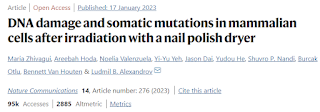Many of my students love a good manicure. Sometimes, they come in with full-on talons. The youth love manicures.
As such, the recent viral headlines about gel nail polish lamps and cancer matter to them.
 |
| #scicomm |
But what did the original research really study?
 |
| https://www.nature.com/articles/s41467-023-35876-8#Sec12 |
(CHECK OUT THIS GREAT RM IMAGE FROM THE ORIGINAL RESEARCH!!!)
This short NPR story by Rachel Treisman is a great summary. The NPR audio story is accompanied by a written report. In that report, Treisman succinctly summarizes the methodology:
 |
| https://www.npr.org/2023/01/26/1151332361/gel-nails-cancer-manicure-safe |
4. Let's talk about DVs
Some of the headlines say cancer, but the actual outcome measures cell death, DNA damage, and mitochondria damage.
5. Let's talk about using lab research to establish a basic premise
This wasn't a huge epidemiological study looking at actual cancer rates. It was nice, tidy lab research that used disembodied cells to study the first thing that must be established in the gel nail lamp:cancer argument. And that is the immediate effects of UV light on cells.


Comments
Post a Comment